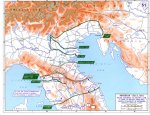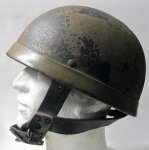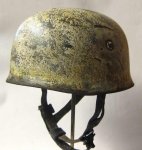It has been years since I have read about Market Garden but my recollection is that the major reason, other than the airborne divisions running into the unexpected German armored divisions, was the fact that the roads were narrow causeways through the low country which essentially meant that there was only a single route for the armored units to relieve the airborne divisions. The German troops merely had to knock out the lead tank and the roadway was completely blocked. A large German force was not required to accomplish this. This was the major planning blunder that doomed the operation and is typical of so much involved in all human endeavors. Our hubris often leads us to fail to recognize the greatest troll that may appear in our path!
75th anniversary of D-Day...
- Thread starter crimsonaudio
- Start date
- Status
- Not open for further replies.
It was Monty's plan but it appears to me that Ike was led by Monty to abandon his broad front strategy in favor of this "lighting stroke" into Germany. We can see through the maps of the front and the failure of Market Garden that the seeds were being sewn for the desperate battle in the Ardennes only a few months in the future.It's been years and years since I read "Bridge Too Far," but, IIRC, the blame was laid squarely on Monty's head. It's a puzzle to me, since he was normally so cautious...
TBF, I've always wondered if Monty were trying to shake his "timid" image...It has been years since I have read about Market Garden but my recollection is that the major reason, other than the airborne divisions running into the unexpected German armored divisions, was the fact that the roads were narrow causeways through the low country which essentially meant that there was only a single route for the armored units to relieve the airborne divisions. The German troops merely had to knock out the lead tank and the roadway was completely blocked. A large German force was not required to accomplish this. This was the major planning blunder that doomed the operation and is typical of so much involved in all human endeavors. Our hubris often leads us to fail to recognize the greatest troll that may appear in our path!
I've tried reading Monty's memoir, but it's just like trying to read any narcissist's. It's nauseating after a while...It was Monty's plan but it appears to me that Ike was led by Monty to abandon his broad front strategy in favor of this "lighting stroke" into Germany. We can see through the maps of the front and the failure of Market Garden that the seeds were being sewn for the desperate battle in the Ardennes only a few months in the future.
That's would be my assessment, but I am normally reluctant to wrestle historical subjects to the psychiatrist's couch because I have seen so much bad history come from that procedure.TBF, I've always wondered if Monty were trying to shake his "timid" image...
September 18, 1944: Day two of Operation Market Garden: the British XXX Corps is able to advance 20 miles, relieving the troops of the US 101st Airborne Division at Veghel and captured Eindhoven, and the 101st Airborne is forced to stop to repair the bridge at Son. To the north, the US 82nd and British 1st Airborne Divisions continue to resist. German forces launch strong attacks against the British positions at Arhnem - attempts to reinforce the battalion in the town at the bridge prove fruitless as heavy fog prevents airdrops until late in the afternoon. Elements of 82nd Airborne engage in heavy street fighting in Njmegan as they move on the bridge there.
US 1st Army continues to attack Aachen, Lammersdorf, and Monschau and Patton’s US 3rd Army remains heavily engaged around Metz and Luneville. US 7th Army and French Army B are regrouping north of Belfort.
After six weeks of some of the fiercest battles fought on the Western Front during all of the war, the US 9th Army captures the port city of Brest, France. Though heavily fortified and defended, Brest is an absolute necessity in order to ensure the timely delivery of the enormous amount of supplies required by the invading Allied forces - it is estimated that the 37 Allied divisions on the continent by September need 26,000 tons of supplies each day.
Overnight, above Germany, RAF Bomber Command sends 213 aircraft to attack Bremerhaven, destroying much of the city and 33 aircraft to attack Berlin.
On the eastern front, Soviet 3rd Baltic Front continues pushing through Estonia as the German 18th Army and Group Narva withdraw. As the German forces withdraw, Estonian provisional government surfaces in Tallinn and declares neutrality in Russo-German war.
In occupied Poland, American B-17 bombers drop 1284 containers of supplies in an attempt to replenish the embattled Polish Home Army (AK) in Warsaw, but only 228 fall on territory still controlled by the Poles. This is the only major supply drop by the western Allies allowed by the Soviets. The US planes are escorted by 64 fighters and land in Soviet territory after completing their mission.
In Italy, British 8th Army is attacking main positions of the Rimini Line while US 5th Army attacks around Pietrasanta, Camaiore, Castelvecchio, Pistoia, Futa pass, and Femmina Morta. Overhead, US 12th Air Force aircraft attack targets around Rimini and in the Po valley.
Pictured: B-24J Liberator of the 854th Bomb Squadron guided to the ground after being hit by light-flak during low-level supply drop for the 82nd and 101st Airborne near Eindhoven, Holland, September 18, 1944.; Captain Ogilvie of the UK Glider Pilot Regiment, who landed in his kilt during Operation Market Garden, preparing for a patrol next to a jeep, September 18, 1944; Troops of US 101st Airborne Division with members of Dutch resistance at the Eindhoven cathedral, the Netherlands, September 18, 1944; A forty-foot hole in the roof of a U-boat pen in Brest, France that received a direct hit during the Allied bombardment.
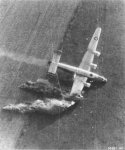
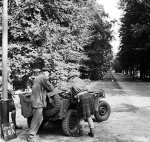
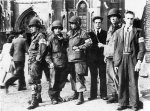
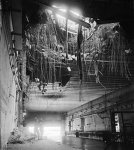
US 1st Army continues to attack Aachen, Lammersdorf, and Monschau and Patton’s US 3rd Army remains heavily engaged around Metz and Luneville. US 7th Army and French Army B are regrouping north of Belfort.
After six weeks of some of the fiercest battles fought on the Western Front during all of the war, the US 9th Army captures the port city of Brest, France. Though heavily fortified and defended, Brest is an absolute necessity in order to ensure the timely delivery of the enormous amount of supplies required by the invading Allied forces - it is estimated that the 37 Allied divisions on the continent by September need 26,000 tons of supplies each day.
Overnight, above Germany, RAF Bomber Command sends 213 aircraft to attack Bremerhaven, destroying much of the city and 33 aircraft to attack Berlin.
On the eastern front, Soviet 3rd Baltic Front continues pushing through Estonia as the German 18th Army and Group Narva withdraw. As the German forces withdraw, Estonian provisional government surfaces in Tallinn and declares neutrality in Russo-German war.
In occupied Poland, American B-17 bombers drop 1284 containers of supplies in an attempt to replenish the embattled Polish Home Army (AK) in Warsaw, but only 228 fall on territory still controlled by the Poles. This is the only major supply drop by the western Allies allowed by the Soviets. The US planes are escorted by 64 fighters and land in Soviet territory after completing their mission.
In Italy, British 8th Army is attacking main positions of the Rimini Line while US 5th Army attacks around Pietrasanta, Camaiore, Castelvecchio, Pistoia, Futa pass, and Femmina Morta. Overhead, US 12th Air Force aircraft attack targets around Rimini and in the Po valley.
Pictured: B-24J Liberator of the 854th Bomb Squadron guided to the ground after being hit by light-flak during low-level supply drop for the 82nd and 101st Airborne near Eindhoven, Holland, September 18, 1944.; Captain Ogilvie of the UK Glider Pilot Regiment, who landed in his kilt during Operation Market Garden, preparing for a patrol next to a jeep, September 18, 1944; Troops of US 101st Airborne Division with members of Dutch resistance at the Eindhoven cathedral, the Netherlands, September 18, 1944; A forty-foot hole in the roof of a U-boat pen in Brest, France that received a direct hit during the Allied bombardment.




Yes, but it's human nature to speculate about motivation. It's too fascinating...That's would be my assessment, but I am normally reluctant to wrestle historical subjects to the psychiatrist's couch because I have seen so much bad history come from that procedure.
At Fort Campbell, Kentucky, today's home of the 101st Airborne Division, there are drop zones called Veghel DZ and Son DZ.September 18, 1944: Day two of Operation Market Garden: the British XXX Corps is able to advance 20 miles, relieving the troops of the US 101st Airborne Division at Veghel and captured Eindhoven, and the 101st Airborne is forced to stop to repair the bridge at Son.
September 19, 1944: It’s Tuesday - today is D+105, marking 15 weeks since the D-Day Invasion at Normandy and the beginning of the liberation of Europe.
As Operation Market Garden continues, resupply and reinforcement airdrops also continue to be hindered by bad weather. The bridge at Son is completed during the night and tanks from Guard Armored Division start moving a dawn. The armor, along with the British XXX Corps, advances 20 miles, making contact with the 82nd Airborne at Grave, just outside Nijmegen, where German resistance is fierce and the bridge is not yet secured. At Arnhem, British paratroopers from the 1st Airborne Division are forced to abandon attempts to break into the city. Serious resistance and heavy losses forces them to withdraw to Oosterbeek.
Overnight, 78 German bombers take off and attack Eindhoven - the city center is destroyed, killing over 200 people in addition to hitting an ammunition convoy. Elements of the 101st, based in and around the city, escape loss. The 506th Parachute Infantry Regiment rushes into the burning city and rescues civilians throughout the night.
Elements of Canadian 1st Army attack south of Scheldt estuary and US 1st Army attacks Muensterbusch, Weissenberg Hill, Stolberg, Zweifall, and Huertgen. To the south, US 3rd Army remains heavily engaged at Metz and Luneville and US 7th Army moves into jumping off positions for attack toward Epinal. French Army B holding positions around Belfort.
Over northwestern Europe, US 9th Air Force supports ground troops up and down the front. RAF Bomber Command sends 646 aircraft to attack besieged fortress of Calais.
The Belgian Parliament meets for the first time since May 1940.
On the Eastern Front, the Soviet offensive in the Baltic continues. Forces of the 3rd Baltic Front capture Valga in Estonia.
In Italy, the British 8th Army continues to attack and German units withdraw from Rimini Line overnight. US 5th Army is fighting around Monte Prano, Pescia, Firenzuola, and Futa pass.
Pictured: The people of Eindhoven lined the streets of the town on September 19, 1944 to celebrate armored vehicles of British XXX Corps passing through - no one knew that the Germans would destroy much of the city later that evening; Eindhoven on September 20, 1944 - the morning after the German bombing; Four men of the 1st Paratroop Battalion, British 1st Airborne Division, take cover in a shell hole outside Arnhem, September 19, 1944.; Situation map from September 19, 1944
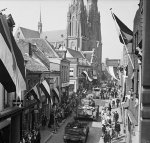
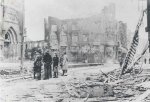
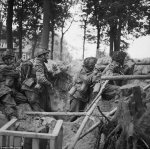
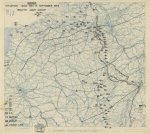
As Operation Market Garden continues, resupply and reinforcement airdrops also continue to be hindered by bad weather. The bridge at Son is completed during the night and tanks from Guard Armored Division start moving a dawn. The armor, along with the British XXX Corps, advances 20 miles, making contact with the 82nd Airborne at Grave, just outside Nijmegen, where German resistance is fierce and the bridge is not yet secured. At Arnhem, British paratroopers from the 1st Airborne Division are forced to abandon attempts to break into the city. Serious resistance and heavy losses forces them to withdraw to Oosterbeek.
Overnight, 78 German bombers take off and attack Eindhoven - the city center is destroyed, killing over 200 people in addition to hitting an ammunition convoy. Elements of the 101st, based in and around the city, escape loss. The 506th Parachute Infantry Regiment rushes into the burning city and rescues civilians throughout the night.
Elements of Canadian 1st Army attack south of Scheldt estuary and US 1st Army attacks Muensterbusch, Weissenberg Hill, Stolberg, Zweifall, and Huertgen. To the south, US 3rd Army remains heavily engaged at Metz and Luneville and US 7th Army moves into jumping off positions for attack toward Epinal. French Army B holding positions around Belfort.
Over northwestern Europe, US 9th Air Force supports ground troops up and down the front. RAF Bomber Command sends 646 aircraft to attack besieged fortress of Calais.
The Belgian Parliament meets for the first time since May 1940.
On the Eastern Front, the Soviet offensive in the Baltic continues. Forces of the 3rd Baltic Front capture Valga in Estonia.
In Italy, the British 8th Army continues to attack and German units withdraw from Rimini Line overnight. US 5th Army is fighting around Monte Prano, Pescia, Firenzuola, and Futa pass.
Pictured: The people of Eindhoven lined the streets of the town on September 19, 1944 to celebrate armored vehicles of British XXX Corps passing through - no one knew that the Germans would destroy much of the city later that evening; Eindhoven on September 20, 1944 - the morning after the German bombing; Four men of the 1st Paratroop Battalion, British 1st Airborne Division, take cover in a shell hole outside Arnhem, September 19, 1944.; Situation map from September 19, 1944




That is actually the same wiki map that was causing my confusion. The largest green box on the left says:View attachment 4396
On the map it is called the Pisa-Rimini Line, the Green Line, and the Gothic Line. Rimini is a city of the Adriatic coast.
Pisa-Rimini line
Green line
Gothic line
It’s unclear from that which is the green line or if they are the same. No big deal.
The Gothic Line was renamed the Green Line by the Allies in mid-1944. The Gothic Line was actually two lines about 12 miles apart and the Rimini Line was part of the secondary line. Rimini was considered the gateway into northern Italy, so it was heavily defended but also heavily attacked.That is actually the same wiki map that was causing my confusion. The largest green box on the left says:
Pisa-Rimini line
Green line
Gothic line
It’s unclear from that which is the green line or if they are the same. No big deal.

(Note Verde-1 and Verde-2 in the map above - 'verde' is Italian for 'green')
I've read on Dutch boards that the consensus of opinion on the Eindhoven raid was that 78 bombers was all the Germans had fuel for. This is getting a bit ahead, but it's an account of the last gasp massive fighter raid by the Germans on January 1, against Allied airfields and named "Bodenplatte"...
History.net
History.net
Last edited:
Interesting! American-style helmets...September 19, 1944: It’s Tuesday - today is D+105, marking 15 weeks since the D-Day Invasion at Normandy and the beginning of the liberation of Europe.
As Operation Market Garden continues, resupply and reinforcement airdrops also continue to be hindered by bad weather. The bridge at Son is completed during the night and tanks from Guard Armored Division start moving a dawn. The armor, along with the British XXX Corps, advances 20 miles, making contact with the 82nd Airborne at Grave, just outside Nijmegen, where German resistance is fierce and the bridge is not yet secured. At Arnhem, British paratroopers from the 1st Airborne Division are forced to abandon attempts to break into the city. Serious resistance and heavy losses forces them to withdraw to Oosterbeek.
Overnight, 78 German bombers take off and attack Eindhoven - the city center is destroyed, killing over 200 people in addition to hitting an ammunition convoy. Elements of the 101st, based in and around the city, escape loss. The 506th Parachute Infantry Regiment rushes into the burning city and rescues civilians throughout the night.
Elements of Canadian 1st Army attack south of Scheldt estuary and US 1st Army attacks Muensterbusch, Weissenberg Hill, Stolberg, Zweifall, and Huertgen. To the south, US 3rd Army remains heavily engaged at Metz and Luneville and US 7th Army moves into jumping off positions for attack toward Epinal. French Army B holding positions around Belfort.
Over northwestern Europe, US 9th Air Force supports ground troops up and down the front. RAF Bomber Command sends 646 aircraft to attack besieged fortress of Calais.
The Belgian Parliament meets for the first time since May 1940.
On the Eastern Front, the Soviet offensive in the Baltic continues. Forces of the 3rd Baltic Front capture Valga in Estonia.
In Italy, the British 8th Army continues to attack and German units withdraw from Rimini Line overnight. US 5th Army is fighting around Monte Prano, Pescia, Firenzuola, and Futa pass.
Pictured: The people of Eindhoven lined the streets of the town on September 19, 1944 to celebrate armored vehicles of British XXX Corps passing through - no one knew that the Germans would destroy much of the city later that evening; Eindhoven on September 20, 1944 - the morning after the German bombing; Four men of the 1st Paratroop Battalion, British 1st Airborne Division, take cover in a shell hole outside Arnhem, September 19, 1944.; Situation map from September 19, 1944
View attachment 4399
View attachment 4400
View attachment 4401
View attachment 4402
The "Tommy" style helmets would almost be a parachute in themselves. I've read the rationale for them but I've forgotten it...I think those are Helmets, Steel Airborne Troops.
View attachment 4404
I think the Tommy helmets were stamped steel and thus cheap to make.The "Tommy" style helmets would almost be a parachute in themselves. I've read the rationale for them but I've forgotten it...
And they were essentially copies of the Brodie helmet from WWI, which was designed for trench warfare and therefore had a wide brim to help block shrapnel from shells exploding above the troops in the trenches.I think the Tommy helmets were stamped steel and thus cheap to make.
- Status
- Not open for further replies.
Latest threads
-
Bama Game Thread: Bama Gymnastics - NCAA Championship Semi-finals (ESPN2 | 4/18 @ 8pm CT)
- Started by BamaNation
- Replies: 2
-
No. 1 Visits Tuscaloosa for Second Straight Week as Alabama Hosts Top-Ranked Texas A&M
- Started by Diamond Tide
- Replies: 0
-
-
I'm Declaring the Emperor has no clothes (NCAA rules implosion)
- Started by BamaNation
- Replies: 26
-
Home-and-Home Series Wraps Up as Alabama Welcomes UAB on Tuesday
- Started by Diamond Tide
- Replies: 1
-


